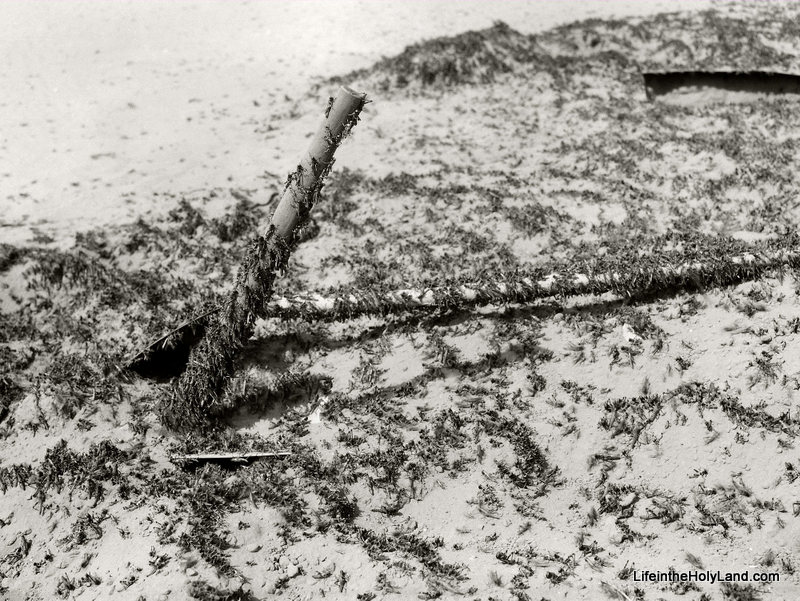(Post by Seth M. Rodriquez)
Over the last few days, swarms of locusts have threatened Israel and Egypt. The Egyptian swarm was estimated to be at least 30 million insects, while the swarm that entered Israel was only about 1 million. In 1915, a similar locust swarm wreaked havoc in Palestine, and photographers and scientists had one of their first opportunities to study these insects up close.
In Volume 6 of The American Colony and Eric Matson Collection, there are over 80 pictures of the locust plague of 1915 as well as a copy of an article published in the National Geographic about the incident. Locusts are mentioned over 30 times in the Bible, and the 1915 invasion provided researchers with new insights into these creatures and the damage they can cause when they travel in such large numbers. Essentially what happened was the locusts flew into the region from the northeast, laid their eggs in various places, the parents died while the eggs hatched, the larvae crawled for miles in a direction back toward the northeast, and after reaching maturity the young insects flew off towards the east. Through this whole process, the insects ate everything in their path: the adults ate on their way in and the young ate on their way out … or as Joel 1:4 put it: “What the cutting locust left, the swarming locust has eaten. What the swarming locust left, the hopping locust has eaten, and what the hopping locust left, the destroying locust has eaten.” (ESV)
In the photo above (click to enlarge), the crawling locusts are covering digging tools used by the residents of the area to fight the onslaught of the insects. The fought them in various ways:
- Digging up the eggs before they hatched.
- Setting up long lines of metal sheets and directing the locusts to pits in the ground where the locusts would be squashed (by men holding their noses) and then buried.
- Poisoning them by adding arsenic to grain and spreading the grain in their path.
- Using a flame thrower to burn the insects while they ate the vegetation.
The entire episode, both the insect itself and the responses of the locals, is extremely fascinating.
Some Muslim locals were resigned to the fact that the locusts had been sent by Allah and thus there was no use in fighting them. Other locals tried to trick the authorities when they were required to gather a certain quota of locust eggs (for example, by rolling white clay into what looked like a locust egg). Still others joined the fight against the insects. The following story of one fight against the locusts is recorded in the National Geographic article:
One evening while trapping them on the upper side of the hill we learned just in time that an immense number were just about to enter the property from the opposite side. At once all efforts turned in this direction, and the trap was sunk into the lower edge of the field toward which they were making; but no sooner had it been set in place than the locusts again changed their course. Notwithstanding the laborious task involved, the trap had to be moved, during which process it was nip and tuck to keep the locusts from escaping. Once, however, they made in the right direction, they jumped, hundreds at a time, into this death trap.
The evening hours were now upon us; the locusts, weary from being driven and benumbed from the cool breezes, seemed to near the trap exhausted, while those behind kept piling up till the earth for a small space was covered layers deep. To facilitate matters, with spade and rake they were scraped into the trap, now constantly being emptied.
Thus in about an hour’s time four large sacks full were caught and destroyed each containing no less than 100,000 of these insects. Many escaped and made for a near-by thorny patch, on which was now piled more dry sticks and thistles, which when set afire burned alive many thousands more. The above is but average example showing how and in what quantities they were caught. (John D. Whiting, The National Geographic Magazine, Volume XXVIII, No. 6 [Dec. 1915], pp. 535-536.)
By way of contrast, this week the Israeli authorities were able to eliminate a swarm of locusts by spraying pesticides over thousands of acres in a single day. One hundred years of developments in technology can go a long way.
This photograph and over 600 other images of “Traditional Life and Customs” are available in Volume 6 of The American Colony and Eric Matson Collection and can be purchased here for $20 (with free shipping). See here for another photograph of the crawling locust in this collection, and see here for a previous post on this locust plague with two additional pictures.
